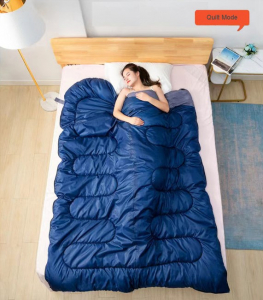News Center+ 查看更多
News Center
+ 查看更多
Choosing the Right Sleeping Bag: Weight, Warmth, and Mobility+ 查看更多
Choosing the Right Sleeping Bag: Weight, Warmth, and Mobility
+ 查看更多
Date:2023-12-23
Selecting the ideal sleeping bag is pivotal for a comfortable night's rest during outdoor adventures. Several key factors, such as weight, warmth, and mobility, play significant roles in determining the suitability of a sleeping bag for specific camping needs.
1. Weight Considerations
The weight of a sleeping bag is a critical factor, particularly for backpackers and hikers. Ultralight sleeping bags prioritize minimal weight without compromising on warmth or durability. Consider the trade-off between weight and insulation level when selecting a sleeping bag.
2. Warmth and Insulation
The warmth provided by a sleeping bag is determined by its insulation. Down insulation offers an exceptional warmth-to-weight ratio but can lose insulation properties when wet. Synthetic insulation, though slightly heavier, retains warmth even when damp. Understanding temperature ratings assists in choosing a bag suitable for expected weather conditions.
3. Mobility and Packability
The mobility and packability of a sleeping bag are crucial for ease of transportation. Modern sleeping bags are designed to be compressible and pack into compact sizes, fitting neatly into backpacks or storage compartments without occupying excessive space.
4. Shape and Design
Sleeping bag shapes vary, offering different balances between comfort and warmth retention. Mummy-shaped bags have a snug fit, minimizing air space to retain heat. Rectangular or semi-rectangular bags offer more room for movement but might compromise thermal efficiency.
5. Insulation Distribution
Understanding insulation distribution within a sleeping bag aids in determining warmth. Bags with variable insulation—more insulation on the top and less beneath the body—optimize warmth where it's most needed while reducing overall weight.
6. Shell Material and Durability
The shell material of a sleeping bag affects its durability and water resistance. Ripstop nylon or polyester shells provide durability while remaining lightweight. Durable water repellent (DWR) treatments enhance water resistance, preventing moisture absorption.
7. Zipper Functionality and Features
Zippers in sleeping bags should be durable and function smoothly. Some bags incorporate anti-snag features or double zippers for adjustable ventilation or joining multiple bags together for couples' camping.
8. User Reviews and Recommendations
User experiences shared through reviews offer practical insights into a sleeping bag's performance. Evaluating reviews regarding warmth, weight, durability, and overall satisfaction assists in making informed decisions.
Conclusion
Choosing the right sleeping bag involves a balance between weight, warmth, and mobility. By considering these crucial factors—weight for portability, insulation for warmth, and mobility for ease of movement—campers can select sleeping bags that cater to their specific needs, ensuring a comfortable and restful night's sleep in the great outdoors.

